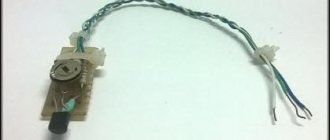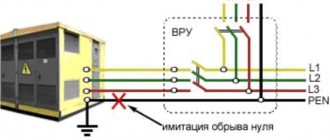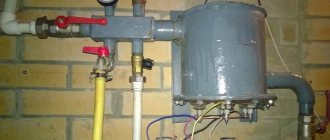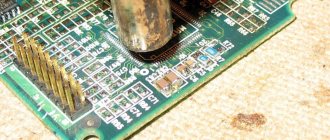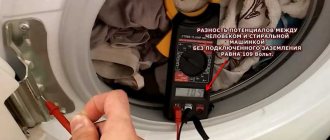Failure of plumbing fixtures is one of the most common causes of leaks. Agree, being the culprit of a flood and its victim is both unpleasant and financially expensive.
A timely installed anti-flood system will help avoid disaster even in the event of damage to pipes and disruption of the integrity of the water circuit. Before installing a water leakage sensor with your own hands, you need to understand the structure of the mechanism and the operating features of different models.
We will talk about the design features and operating principle of the device. We will explain the procedure for assembling the protective system and connecting the controller. Visual photo instructions and thematic videos will help you choose a device and install it yourself.
How to signal a water leak
The solution to the problem came into everyday life from the yachting world. Since the ship's lower tier rooms (especially holds) are located below the waterline, water regularly accumulates in them. The consequences are clear, the question is how to deal with it. It is irrational to assign a separate sailor on watch for control. Then who will give the command to turn on the sump pump?
There are effective tandems: a water presence sensor and an automatic pump. As soon as the sensor detects that the hold is full, the pump motor turns on and pumping occurs.
The water sensor is nothing more than a regular float on a hinge connected to the pump switch. When the water level rises by 1–2 cm, the alarm and the sump pump motor are triggered at the same time.
Comfortable? Yes. Safely? Of course. However, such a system is unlikely to be suitable for a residential building.
- Firstly, if the water reaches a level of 1–2 cm over the entire area of the room, it will run through the threshold of the front door onto the landing (not to mention the neighbors below).
- Secondly, a bilge pump is completely unnecessary, since the cause of the breakthrough must be immediately found and localized.
- Thirdly, the float system for rooms with a flat floor is ineffective (unlike watercraft with a keeled bottom). By the time the “required” level for operation is reached, the house will fall apart from dampness.
Therefore, a more sensitive alarm system against leaks is needed. This is a question of sensors, and the executive part comes in two types:
1. Alarm only. It can be light, sound, or even connected to a GSM network. In this case, you will receive a signal on your mobile phone and will be able to remotely call an emergency team.
2. Turning off the water supply (unfortunately, this design does not work with the heating system, only water supply). After the main valve, which supplies water from the riser to the apartment (it does not matter whether it is before or after the meter), an electromagnetic valve is installed. When a signal is sent from the sensor, the water is shut off and further flooding is stopped.
Naturally, the water shut-off system also signals a problem in any of the above ways. These devices are offered in a wide range by plumbing stores. It would seem that material damage from a flood is potentially higher than the price of peace of mind. However, the majority of citizens live by the principle “until thunder strikes, a man will not cross himself.” And more progressive (and prudent) homeowners make a water leakage sensor with their own hands.
Classification of sensors by nature of operation
Devices are distinguished in different ways, one of them is the capabilities and behavior of the gadget in a critical situation.
- The device body contains all the functionality that ensures its autonomous operation. A leak alert is indicated by a sound or light signal. There are models that signal the presence of deviations in the operation of the water supply system in the form of an SMS message to the phone.
- Information about leakage through the wired system is sent to the control panel. This electronic device, after receiving an alert, processes the data and gives a command to the solenoid valve, which can turn off the water supply. This is the principle used by the AquaStorh water leak protection system.
- The wireless leak protection system differs from the previous one in that the sensors send signals to the remote control using radio communication.
How to choose flood protection
In terms of efficiency, cheap and expensive devices are almost the same, with the exception of manufacturing defects that can be present in any system. Each manufacturer presents its product, but this is just advertising and nothing more.
In the leakage protection system with the Gidrolock , the complete delivery includes 3 sensors, while you can connect another 40 sensors without installing additional units.
Protection complexes Akvastorozh is initially equipped with 4 sensors and you can connect 10 more. If you install additional blocks, the number of sensors can be increased to 375.
Neptune system kit includes only 2 sensors; the rest must be purchased separately. Moreover, without installing additional units, the system can support no more than 10 water leakage sensors.
A wireless sensor system significantly increases the cost of the system, so if you are satisfied with a wired system, it is better to give preference to it. Also, the cost of the system increases if it is possible to install additional taps.
As we found out, for effective operation you need no more than 2 ball valves with solenoid valves mounted on cold and hot water risers behind the inlet valves. If you buy a system with 6-8 taps, you will overpay for something you will never use.
Some manufacturers, when advertising their products, speculate on such a value as operating voltage. And for protection systems it ranges from 5-12 V.
At the same time, the current strength in the sensor wires is absolutely safe, and the current strength in the faucet wires, although it reaches 1 A, lasts only a few seconds, so the difference in operating voltages is not at all significant.
One of the main indicators of system performance is the tap shut-off time. In cheap Neptune , this figure reaches 30 seconds, while the most modern Akvastorozh are capable of turning off taps in just 2-3 seconds.
Please note that if heating or water pipes rupture, 20-25 liters of water can spill out in 30 seconds.
Another important indicator is the presence of a battery included in the kit, which ensures autonomous operation of the system in the event of a power outage.
What to consider in a flood sensor
It is worth knowing the important aspects when choosing a water leakage sensor. When choosing a protective device, it is necessary to take into account its characteristics:
- Method and place of attachment. The system should be located where there will be no erroneous signals about the occurrence of an emergency if water accidentally gets on the sensors or if there is a high humidity level in the room.
- Power supply. Are there any requirements for the installation of the system when using industrial voltage? It is better to buy devices that run on batteries.
- Sensitivity threshold. You can adjust the sensors for sensitivity or not.
- Manufacturer. When a device is purchased in a store, it comes with a warranty. In case of breakdown, technical assistance is provided.
- Time to close the tap. The lower it is, the less chance of flooding.
- Availability of battery. If wired equipment is installed, provision should be made for the system to operate autonomously when the power supply is turned off.
- Model type. A wireless system costs more.
Water sensors are widely used in household appliances. If connected correctly, the device will last much longer than a homemade circuit. Water flood regulators are in demand among the population, because the low quality of pipe connections and cheap Chinese taps leads to more frequent accidents recently. When the device hits a sensitive water sensor, it raises an alarm in time.
General placement principles
Even a person without experience can handle the installation of the Akvastorozh system. You need to follow a few fairly simple steps:
- Install electric cranes. Directly into the hot and cold pipes in the place behind the inlet valves. You need to close the inlet valves, then disconnect the water supply from them, insert the electric taps and return the missing part of the wiring (technical details will be described below).
- Install the controller. Where it is dry and access is not difficult, for example, in a plumbing closet or in a hallway. Humidity in the room should not exceed 70%. The controller is easily attached using a special plate and two screws to any surface with drilled holes.
- Place and connect leakage sensors to the controller. Installing wired sensors involves laying a wire (the seams in tiled floors are also suitable for this), fixing the bottom to the floor with a screw or double-sided tape, securing the plate to the bottom, and attaching a decorative cap. Wireless sensors do not require anything other than securing them with double-sided tape.
- Connect other components to the controller. First the electric cranes, then the battery pack.
Rules for installing an anti-flood system
May differ when using different types of sensors - for example, wired and wireless. However, the basic rules remain the same - careful marking of points, sequence of arrangement processes, connection for verification after assembly.
Ball valve insert
After the water is turned off and the water meter is removed, the water supply is cut next to the blocked valve. This is the most difficult stage of the installation process and requires special tools and fasteners. Fasteners and tools depend on the diameter of the pipes and the material they are made of - locknuts or split couplings may be required.
The best places to install water leak sensors
The owner of the apartment probably already knows where in the communications system an emergency situation is most likely. The leak locations do not change, even if new plumbing is installed. If this is a new room, then the optimal place would be the transition between pipes or at the lowest point of the room, where the floor is sloped.
Controller installation rules
A zero and a phase must be connected to the device, and in order not to confuse which terminals the wires are connected to, it is better to use the instructions for use from the manufacturer, or number them for the convenience of the worker.
Checking the system operation
After the green signal lights up on the control module, the sensor plate is moistened with liquid from the tap. If all components of the sensor are correctly connected, an alarm will sound, a red light will light up and the water supply will stop. You can return the device to standby mode by removing the water from the plate and rebooting the device.
Composition and diagram of a standard protection device
Standard equipment includes:
- Ball valves with an electric drive, with the help of which the function of blocking the flow of water in pipes is realized. The valve interrupts the flow and reports an accident. One of the disadvantages of the wedge method of shutting off the water is the need to install a tap on each pipeline, and their diameter may differ. Thus, the Neptune anti-leak installation has valve sizes from 1 to ½. More details about the available dimensions should be specified in the instructions for the specific device.
- Controller for control. From here a signal is sent to the taps to shut off the water, after which a notification is sent to the owners of the bathroom. The unit can be connected to the sensor wired or wirelessly. The panel provides basic information about the state of the taps and the charge level.
- Sensor. It can be autonomous or connected to the electricity network. The installation location is selected at a point with a risk of leakage.
As an addition, transmitters can be attached to control the device from a distance via Wi-Fi or with the ability to notify about the status of the water supply via SMS. The number of additional functions directly affects the cost of protection. Rich configurations are found in models with prices above the average level.
Operating principle of leakage sensors
Speaking about the block diagram, everything is very simple. A certain element fixes the liquid at the point of its placement and sends a signal to the executive module. Which, depending on the settings, can give light or sound signals, and (or) give a command to close the valve.
How the sensors work
We will not consider the float mechanism, since it is not effective at home. Everything is simple there: the base is fixed to the floor, a float is suspended on a hinge, which, when floating, closes the switch contacts. A similar principle (mechanical only) is used in the toilet cistern.
The most commonly used sensor is a contact sensor, which uses the natural ability of water to conduct electrical current.
Of course, this is not a full-fledged switch through which 220 volts passes. A sensitive circuit is connected to two contact plates (see illustration), which detects even a small current. The sensor can be separate (as in the photo above), or built into a common housing. This solution is used on mobile autonomous sensors powered by a battery or accumulator.
If you do not have a smart home system, and water is supplied without any solenoid valves, a simple sensor with an audible alarm can be used as a starting option.
How to make a water leakage sensor with your own hands
The assembly principle will differ depending on the model planned for installation. In any case, this is an alarm system that works according to one of three principles - wired, wireless, or more complex, with sensitivity adjustment.
Wired homemade sensor
Can be done using a simple electrical circuit and a signal wire connected to the control unit. The circuit works by closing the contact with water.
Wireless homemade sensor of the simplest design
Wireless works on the same principle, only the signal is supplied by energy coming not through a cable, but from an autonomous reservoir.
A more complex circuit with a sensitivity regulator
It can include several sensors and is used when it is necessary to monitor a larger area. In any case, the components of the design can be purchased separately at a radio store, and the diagram can be drawn up independently or looked at by specialists.
Homemade alarms
They are always much cheaper than factory-made products; it is not necessary to make them powered by electricity - for certain needs you can use float ones, or use someone else’s homemade developments.
How the device works
Various physical properties of water are taken as the basis for analyzing the presence of leaks.
Sensors that measure electrical conductivity between contacts are most often used to monitor the presence of leaks. Such a circuit, assembled independently, often replaces an industrial design. The contacts themselves are usually made of a foil-covered board, between which an insulating track is cut.
We also recommend that you learn about the faucet with a water switch, how it is designed, works and functions.
Types of water level meters
Wired modifications require wiring from the meter to the control unit. Advantages of flood sensors:
- no extra costs for sensor assembly;
- no need to use auxiliary power supplies.
One of the disadvantages is the presence of wires. They need to be hidden. It is better to hide the wires on the floor so as not to constantly touch them. The control device can be glued to the wall.
Many are afraid to use homemade sensors in order to be safe from a possible short circuit or, even worse, a fire. Therefore, they choose the more expensive option and buy ready-made controllers from manufacturers.
Wireless models do not require wiring from the sensitive component to the central unit. The flood controller can be installed in any place, as long as it is within the radius of influence of the wireless signal transmitter (300 m). Among the disadvantages: high price, the need to check batteries and change them (frequency - 1-2 years).
There are sensor models that can connect to the main security system.
The water flow regulator consumes almost no electrical energy to operate. The operating voltage of the devices does not exceed 9V. Therefore, there is no risk of electric shock.
DIY water flood regulator: materials and installation
Thanks to a simple device, you can design a wired controller at home. The water sensor consists of common components. Even if you have to buy some materials, it will still be cheaper to make a control device yourself than to buy it.
The sensor that you make at home only serves as a signal about a problem that has arisen. The device will not be able to stop the water.
Basic materials:
- 3 V battery (device CR1632).
- Transistor BC816.
- 1-2 MOhm resistor.
- Piezo emitter included with generator.
- An ordinary plastic bottle.
Step-by-step process for installing a flood regulator:
- The first thing to do is study the design diagram.
- Next, solder the resistor to the piezo emitter.
- Then connect the transistor.
- The circuit is connected to the batteries using blue electrical tape.
- Then we proceed to the construction of the body. We take a large bottle from which we cut off the neck. The bottom is made on one side of the bottle, which is fixed with glue. We make two holes to insert the housing. You need to make holes in the lid for the piezo. Screw the cap onto the neck.
- Now you can control the operation of the structure.
Wireless water leakage controller WD-102
The regulator is designed to establish the flooding of water or other electrically conductive, chemically inactive liquid.
The device consists of two parts. The plate itself, which is considered a sensitive component, and the control unit, which in case of an alarm sends a wireless signal to the GSM control panel. One battery will be enough to power the sensor. The duration of permanent work can be up to a year or more. Battery marking is 23A.
Inside the device there is an antenna for transmitting a signal over a distance of up to 100 meters of line of sight. This device is capable of transmitting a signal, including through walls. That is, the central unit can be in the next room. There are several jumpers inside the device, the so-called black jumpers. With their help, the alarm code is dialed when it is on the rear panel.
Then the code is typed using jumpers. They are black in color. Comes with a sensor. If there is no code on the rear panel, then you need to install at least one jumper in the same order as here. The jumper can be located anywhere, but one needs to be placed. The need for the jumper is that the sensor must have a code.
If the jumper is not installed, then the device will not be able to bind to the main GSM alarm unit.
An important element of the control device is a sensitive plate, which should be placed on the floor or any other surface where it is necessary to control water leakage. The sensitive component can be secured using a piece of double-sided tape. The plate is secured with a sensitive component to the bottom, and can be attached to the top with a plate of double-sided tape.
The sensitive component will be secured when you accidentally step on it. The control unit itself is also secured with double-sided tape on a wall or any other surface inaccessible to water. An exclusively sensitive plate comes into contact with water.
The flood sensor can be used to monitor the levels of different containers: aquariums, barrels and notify about their overflow.
A sensitive plate is installed at the required height and if it is overfilled, the contact closes and the sensor sends a red alarm.
Manufacturing
The base is a wooden block (length-360mm, width-50mm, height-25-30mm), one short end has an angle of 93 degrees. On the base there are parts No. 3, 4, 5, cable, spring.
The sensor (sensitive element) is a strip of paper cut from a student’s notebook and attached to the bottom of the base with several buttons. In the manufacture of part No. 3, an oak block of 150x20x50mm was used. All the bends were made around it, and then the block was taken out and cuts were made with a grinder to attach the cable.
Parts 3 and 4 must be made of stainless steel (at a minimum, the shaded area of these parts must be made of stainless steel)
For better sliding of part No. 4. It is better to first try to make part 3 from cardboard. The bends are shown with red lines. When manufacturing part No. 1, a problem arises - an expanded hole with a diameter of 6 mm.
I solved it in the following way: I drilled one hole and inserted a six screw into it from the inside. The screw should completely cover the hole. After this, a second hole is drilled (the screw and the part are drilled at the same time). The damaged screw is thrown away, the burrs are cleaned with a needle file.
Parts 4, 4a, 4b, the spring are twisted together with one screw from below (a cable is first threaded into the grooves of parts 4a and 4b).
Adjusting a homemade system to protect against water leaks
When manufacturing and adjusting the system, it is advisable to use a device - a piece of pipe more than 20 cm long with a thread with a ball valve screwed onto it. Using this device, you can check the operation of the entire mechanism not at home, but in the garage, workshop, or show the operation of the system to your friends. The device is also useful when drilling holes to connect parts No. 2 and 2a. To do this, you need to clamp these parts in a vice with the device pipe pre-inserted between them. The ball valve handle (parts No. 1 and No. 1a) must be in the closed position, and the slots for the cable in the handle and part No. 2 must match. After this, holes are drilled simultaneously in parts No. 2 and No. 2a. Part No. 5 has two holes: the first is for the finger (when we tension the spring), the second is for the hook. Part No. 5 can be used to adjust the tension of the spring by twisting it along the coils. The base (wooden block 360 x 50 x 25) can be made to a longer length, and after adjustment, the excess part of the block can be cut off. The length of my base is selected for a specific spring. When stretched, the spring force is about 10 kilograms, at the end of actuation it is 4.5 kg. The main condition: a constant force of 1 to 1.5 kilograms must act on the paper tape (to change this force, you need to reduce or increase the angle). To measure, you can use a household spring scale. I bought a spring at a hardware store (a door spring) and cut it into three parts. I took the stainless steel from an old Riga washing machine. I bought the cables at a Moto-Velo store, removed the excess part of the braid with sandpaper, and lubricated them with household grease. I bought a threaded pipe (for the device) at the market. The short end of the block should have an angle of 93 degrees, and parts 3 and 4 should have the same angle at the point of their common contact. The tests were carried out in a damp room (bathroom), a year later I tried to wet the paper tape - everything worked (the ball valve was closed automatically).
How and from what to make a housing for a signaling device
The housing for the alarm should be equally miniature. The most suitable size option is a lid from a liter milk can or from a package of soap bubbles.
The undoubted disadvantage of the device is the fact that the alarm will only help if you are at home. The beeper will not help in your absence. Here we need other means of control that are capable of transmitting a danger signal remotely. It won't be as cheap, but no less effective. The smart home system will help you control everything that happens on your territory, even if you are away. Here is an example of such a system:
Watch this video on YouTube
Think about how much easier your life will be with such devices. A little work and you will protect yourself from unpleasant surprises. What do you think about this? Do you use any devices to avoid leaks? Share your experience with our readers in the comments!
Water leakage sensor on K561LN2 chip
It works according to a scheme similar to the previous one, and also has high sensitivity and reliability.
Composition of parts
In addition to the humidity sensor and the K561LN2 microcircuit, you will need:
- bipolar transistor VT1 series KT3107D;
- resistors for 3 MOhm and 30 K - three pieces, 430 K - two, 430 K and 57K - one each;
- 100 microfarad polar capacitor for operation at voltages up to 16 volts;
- capacitor of 0.01 microns - two and 0.1 microns - also two;
- sound wave generator ZP-22;
- power supply 6÷9 volts.
Homemade sensor of the simplest design
Despite its primitiveness, the sensor is quite effective. Home craftsmen are attracted by this model due to the cheap cost of radio components and the ability to assemble it literally “on the knee”.
The base element (VT1) is an NPN transistor of the BC515 series (517, 618 and the like). It supplies power to the buzzer (B1). This is the simplest ready-made buzzer with a built-in generator, which can be purchased for pennies, or removed from some old electrical appliance. The power required is about 9 volts (specifically for this circuit). There are options for 3 or 12 volt batteries. In our case, we use a Krona type battery.
How the scheme works
The secret is in the sensitivity of the collector-base transition. As soon as a minimum current begins to flow through it, the emitter opens and power is supplied to the sound element. A squeak is heard. An LED can be connected in parallel, adding visual signaling.
The signal to open the collector junction is given by the very water whose presence needs to be signaled. Electrodes are made from metal that is not subject to corrosion. These could be two pieces of copper wire, which can simply be tinned. Connection points on the diagram: (Electrodes).
You can assemble such a sensor on a breadboard.
Then the device is placed in a plastic box (or a soap dish), with holes made in the bottom. It is advisable that if water gets in, it does not touch the circuit board. If you want aesthetics, the printed circuit board can be etched.
The disadvantage of such a sensor is different sensitivity to different types of water. For example, distillate from a leaking air conditioner may go unnoticed.
Based on the concept: an inexpensive autonomous device, it cannot be integrated into a single security system for your home, even a homemade one.
Review and comparison of popular flood protection devices
"Stop Flood Rainbow"
An excellent domestic development with an electronic control unit, sensors and electric shut-off valves.
Aquawatch (aquastop)
It is considered a non-analog protective device that is triggered when the inlet hose breaks. Its installation will not interfere with the operation of the washing machine, but will avoid serious troubles if it breaks down. The manufacturer positions it as absolutely three: reliable, autonomous and safe.
Water leakage sensor on transistor 2N5551
This is the simplest, but quite reliable circuit that even a novice radio amateur can assemble.
Composition of parts
In addition to the humidity sensor, to operate the electrical circuit you will need:
- bipolar NPN transistor 2N5551 or one of its analogs: BC517, BC618, BC 879, 2SD1207, 2SD1853, 2SD2088;
- LED VD1;
- 3 volt power supply, for example, a flat lithium battery;
- three-volt piezo emitter;
- connecting wires.
All these parts are placed in a small plastic box, which serves as a housing, and are connected by soldering with a conventional soldering iron in a surface-mounted manner.
The principle of operation of the electrical circuit
The algorithm for triggering the leakage sensor is quite simple. In the dry position of the contact pads, transistor VT1 is closed and no current passes through its collector-emitter semiconductor junction.
When water appears in the humidity sensor, a short circuit occurs between the electrodes, the positive potential of the battery enters the base of the transistor and opens the transition from the collector to the emitter.
Current begins to flow through the piezo emitter and the parallel-connected LED. A sound and light signal is turned on to notify residents of high humidity.
The assembly and operation of a similar circuit based on the BC517 transistor can be seen in a short video by the owner of “Hands from the Shoulders”.
A more complex circuit, with a sensitivity regulator
The cost of such a scheme is also minimal. Performed on the KT972A transistor.
The operating principle is similar to the previous version, with one difference. The generated signal about the presence of a leak (after opening the emitter junction of the transistor), instead of a signaling device (LED or sound element), is sent to the relay winding. Any low-current device, such as RES 60, will do. The main thing is that the supply voltage of the circuit matches the characteristics of the relay. And from its contacts, information can be sent to the actuator: smart home system, alarm system, GSM transmitter (to a mobile phone), emergency solenoid valve.
An additional advantage of this design is the ability to adjust sensitivity. Using a variable resistor, the collector-base transition current is regulated. You can adjust the response threshold from the appearance of dew or condensation to the full immersion of the sensor (contact plate) in water.
Water leakage sensor on K561LA7 microcircuit
It works according to a more complex, but quite accessible scheme, which has higher reliability and sensitivity.
Composition of parts
In addition to the humidity sensor and the K561LA7 microcircuit for assembly you will need:
- bipolar transistor VT1 series KT315G;
- 1 MΩ, 100 Ohm and kilo-ohm resistors: 1.5 K, 10 K, 300 K;
- two polar capacitors of 2.2 and 47 microfarads for operation under voltage up to 16 volts;
- 200 picofarad capacitor;
- Light-emitting diode;
- sound wave generator ZP-1;
- switch SA-1;
- power supply.
Analogues of K561LA7 are K176LA7, 564LA7, 164LA6, HFF4011BP, HCF4011BE, CD4011A, CD4011. The circuit is not critical to the level of supply voltage and operates reliably within its limits from 5 to 15 volts.
The principle of operation of the electrical circuit
When the dry contacts of the humidity sensor receive voltage from the power source, the LED does not light up and the sound generator does not produce signals: the emitter-collector transistor junction is in the closed state.
When current appears through the humidity sensor, current will flow through the chip keys to the base of the transistor and it will open. The LED will light up and an audible alarm will sound.
When the circuit is powered from the network and not from an autonomous source, it is better to move switch SA1 to the lower position. In this case, the LED will immediately light up, indicating that the leakage sensor is ready to operate, and it will go out when the transistor opens.
By changing the capacitance of capacitor C2, the tone of the sound generator is adjusted.
The current consumption of the electrical circuit is:
- approximately 1 mCa in standby mode;
- 25 mA when triggered.
Which sensor is better to choose for monitoring water leaks?
In this case, expert advice can be found in a variety of ways, but attention should be paid to each of the elements of the scheme. It is better to choose a controller that operates autonomously and is properly protected from external influences, with a minimum response time to danger. There are devices that are able to work with different components of the system and at the same time have backup power. You need to think about how to combine such recommendations with the simplicity and convenience required when installing the device yourself. Don’t buy the first one you come across, but carefully weigh all the parameters. The requirements for cranes are similar - compact, easy to install in the right place, with a suitable wire cross-section and the required length. Sensor – battery-powered or receiving energy from the controller. It is often recommended to buy a wireless water leak sensor - even an amateur can install it in the required location, which cannot be said about sensors with wires.
Operating rules
Almost all models of electric ball valves are equipped with a manual switch. This is an emergency device that should only be used when the power is turned off, otherwise the electric drive can easily be damaged.
Important: Firstly, moisture, and secondly, the use of detergents contribute to the oxidation of the contacts of the leakage sensor. The more protected the contacts, the more durable the sensor itself and the entire system that monitors water leakage. In some sets, the contacts are plated with gold specifically to prevent oxidation.
In some sets, the contacts are plated with gold specifically to prevent oxidation.
The operation of an electric crane can be simplified by placing the shut-off button, for example, in the vestibule. In this way, it becomes possible to shut off the flow of water if the owners are not at home, and they will not be afraid of any problems with the water supply during periods of long absence.
Types of sensors, their design and operating principle
Water is the most important element of human life support. It is not surprising that many safety and protective systems have been developed, and the principles used vary. Even for use at home or at work, there are also separate models. There are also different ways to obtain energy - power supplies, accumulators, batteries, shapes and types of structures, connection location, number of standard elements, etc.
Float devices for monitoring liquid levels in tanks
Not particularly reliable in apartment conditions. They are much more often used in maritime affairs, on yachts or river fleets, although it is believed that this is a cheap and reliable way of signaling in places where water is constantly added from the central water supply system. However, they control only the upper level of liquid, so in everyday life they are usually used in toilet flush tanks.
Ultrasonic Water Leak Sensor
Sends sound waves of a certain frequency and receives a signal reflected from the walls of the container or the controlled thickness of the liquid. The peculiarity of the work is that the obtained value is constantly compared with the standard value; if discrepancies are detected, other devices that provide protection and transmit messages begin to work.
Electrode water leak sensor
The popularity of electrode devices is quite understandable - they work on the difference in electrical conductivity of water and air. It is enough to place the electrodes at the required distance to obtain a guaranteed signal if the electrode falls from air into liquid. Then everything depends on the reliability of the warning system.
Capacitive sensor for monitoring liquid parameters
Several variable electrodes can be installed for the container, allowing you to control the level of different parameters. Such sensors are good if you need to monitor not only leakage, but also several operating modes.
Radar water leak detection sensors
The operating principle is similar to ultrasonic ones. they also produce periodic signals at a certain periodicity and analyze the reflected vibrations. Even aggressive chemical compounds present in liquid form do not pose any obstacles to the installation of such devices.
Hydrostatic action sensor
Often used on an industrial scale, where constant monitoring of changes in liquid level is required. With the help of such sensors, it is possible to automate the supply of ingredients during the synthesis of chemicals or food preparation. The basis of the hydrostatic sensor is an element that is sensitive to changes in fluid pressure.
Some features of popular systems
In order to somehow highlight their protection against water leaks, manufacturers are trying to improve reliability or come up with other moves. It is impossible to systematize these features, but it is better to know about them when choosing.
Capabilities of one block
For different manufacturers, one control unit can control a different number of devices. So it won't hurt to know this.
- One Hydrolock controller can service a large number of wired or wireless sensors (200 and 100 pieces, respectively) and up to 20 ball valves. This is great - at any time you can install additional sensors or install several more cranes, but such a reserve of capacity is not always in demand.
- One Akastorozh controller can service up to 12 wired sensors. To connect wireless, you need to install an additional unit (designed for 8 Aquawatch Radio pieces). To increase the number of wired ones, install another module. This modular expansion is more pragmatic.
- Neptune has control units of different powers. The most inexpensive and simple ones are designed for 2 or 4 taps, for 5 or 10 wired sensors. But they do not check the functionality of the taps and do not have a backup power source.
As you can see, everyone's approach is different. And these are just the leaders. There are even smaller campaigns and Chinese companies (where would we be without them) that either repeat one of the above plans or combine several.
Additional functions
Additional ones are not always unnecessary. For example, for those who are often on the road, the ability to control cranes from a distance is far from superfluous.
- Gidrolok and Akvatorozh have the ability to turn off water remotely. For this purpose, a special button is placed at the front door. Go out for a long time - press and turn off the water. Aquawatch has such a button in two versions: radio and wired. Gidrolok has only wired ones. The Aquastore radio button can be used to determine the “visibility” of the wireless sensor installation location.
- Hydrolock, Akvastorozh and some Neptune variants can send signals to the dispatch service, security and fire alarm systems, and can be built into the “smart home” system.
- Hydrolock and Akvastorozh check the integrity of the wiring to the taps and their position (some systems, not all). In Hydrolock, the position of the locking ball is controlled by an optical sensor. That is, when checking there is no voltage in the tap. The Aqua Watchman has a contact pair, that is, at the time of testing, voltage is present. Protection against water leaks Neptune also monitors the position of the taps using a contact pair.
The hydrolock can be controlled using a GSM module - via SMS (commands to turn on and off). Also, in the form of text messages, signals about accidents and “disappearances” of sensors, broken cables to electric taps and malfunctions can be sent to the phone.
Always being aware of the condition of your home is a useful option.
On the issue of reliability: power supply and other issues
Reliable operation does not only depend on the reliability of the cranes and controllers. Much depends on the power supply, on how long each unit can operate autonomously.
- Aquawatch and Hydrolock have backup power sources. Both systems shut off the water before the backup power supply is completely discharged. Neptune has batteries only for the last two models of controllers, and then the taps do not close when discharged. The rest - earlier and less expensive models - have a 220 V power supply and no protection.
- Neptune's wireless sensors operate at a frequency of 433 kHz. It happens that the control unit “does not see” them through the partitions.
- If the batteries in the Gidroloka wireless sensor run out, the alarm on the controller lights up, but the taps do not close. The signal is generated several weeks before the battery is completely discharged, so there is time to change it. In a similar situation, the Aqua Watchman shuts off the water. By the way, the Hydrolock battery is soldered. So changing it is not so easy.
- Aquawatch has a lifetime warranty on any sensors.
- Neptune has wired sensors that are installed flush with the finishing material.
We looked at all the features of the three most popular manufacturers of water leakage protection systems. In short, the worst thing about the Aquawatch is the plastic gearbox on the drive; the worst thing about the Hydrolock is the high power of the system and, accordingly, the price. Neptune - inexpensive systems are powered by 220 V, do not have a backup power source and do not check the functionality of the taps.
Naturally, there are Chinese leakage protection systems, but you should choose them with caution. https://www.youtube.com/embed/EW3HuvRojwA
Leak sensor on LM7555 chip
This radio element is an analogue of the LM555 microcircuit, only with lower energy consumption parameters. Information about the presence of moisture comes from the contact pad, indicated in the illustration as a “sensor”:
To increase the response threshold, it is better to make it in the form of a separate plate connected to the main circuit with wires with minimal resistance.
The best option in the photo:
If you don’t want to spend money on buying such a “limit switch,” you can etch it yourself. Just be sure to cover the contact paths with tin to increase corrosion resistance.
As soon as water appears between the tracks, the plate becomes a closed conductor. An electric current begins to flow through the comparator built into the chip. The voltage quickly increases to the operating threshold, and the transistor (which acts as a key) opens. The right side of the diagram is the command-executive one. Depending on the execution, the following happens:
- Top diagram. The signal on the so-called “buzer” (beeper) is triggered, and the optionally connected LED lights up. There is another use case: several sensors are combined into a single parallel circuit with a common sound alarm, and the LEDs remain on each block. When the sound signal is triggered, you will accurately determine (by the emergency light) which unit has triggered.
- Bottom diagram. The signal from the sensor is sent to an emergency solenoid valve located on the water supply riser. In this case, the water is shut off automatically, localizing the problem. If you are not at home at the time of the accident, the flood will not happen, and material losses will be minimal.
Information: Of course, you can also make a shut-off valve with your own hands. However, it is better to purchase this complex device ready-made.
The circuit can be made using a printed circuit board layout that is equally suitable for both LM7555 and LM555. The device is powered by 5 volts.
Important! The power supply must be galvanically isolated from 220 volts so that dangerous voltage does not enter a puddle of water during a leak.
In fact, the ideal option is to use a charger from an old mobile phone.
The cost of such a homemade product does not exceed 50–100 rubles (for the purchase of parts). If you have old components in stock, you can reduce costs to zero.
The body is at your discretion. With such a compact size, finding a suitable box will not be difficult. The main thing is that the distance from the common board to the contact plate of the sensor is no more than 1 meter.
Classification of leakage protection systems
Anti-leakage systems are classified according to the following main characteristics:
- By the number of electric taps included.
- According to the method of reporting a leak.
- According to the method of information exchange between sensors and the control unit.
As a rule, the number of electric cranes in a set should be at least two. This is due to the fact that taps must be installed on cold and hot water risers. The number of taps, depending on the chosen system, can be increased.
Types of models by notification method
There are the following ways to report a leak:
- indication on the controller display;
- indication on the display accompanied by noise signals;
- noise alarm, indication and message sending.
Message transmission is possible if the system is equipped with a GSM transmitter. In this case, an SMS message is sent to a phone number that is stored in the device’s memory.
The phone number is entered from the control panel. When the system is connected to the Internet, it is possible to send messages via a GPRS connection.
The magnetic contact sensor is equipped with a GSM notification function for 6 phone numbers. Thanks to this, all residents of the house or apartment will be notified about the leak almost simultaneously
The information displayed on the control panel varies depending on the model. Most often, information is displayed about the presence of leaks, the status of sensors, and the charge level of batteries and batteries.
Wired and wireless sensors
Signals from water leakage sensors can be transmitted to the controller, both via wires and radio channels. In this regard, it is customary to distinguish between wired and wireless systems aimed at preventing flooding.
In wired information transmission systems, a voltage of up to 5 V is supplied to the sensor. In the case of a dry surface, there is no current due to the high resistance between the contacts. As a result of exposure to moisture, the resistance decreases and the current increases.
A small voltage is supplied through the wires to the sensor electrodes, but due to the high resistance between the contacts there is no current. When exposed to moisture, the resistance drops and the circuit closes
To eliminate false alarms, you need to set the minimum current threshold at which the controller will close the solenoid valves.
This is due to the fact that the resistance between the contacts decreases when steam is generated or water is sprayed, but its value remains quite high and does not reach minimum values, as as a result of a leak.
Inside each wireless sensor there is a current comparison circuit that is triggered when a set value is reached. A special transmitter constantly measures the contact resistance and, in the event of flooding, immediately sends a radio alarm signal to the receiver. The receiver and transmitter are tuned to the same frequency.
A special transmitter detects an increase in resistance at the sensor contacts and sends a radio alarm signal, which is received by the radio receiver of the control unit
The transmitter signal is modulated to avoid false alarms due to electromagnetic interference.
Each manufacturer uses its own modulation principles. In this regard, wireless water leakage monitoring sensors cannot be used in other leakage monitoring systems.
General principles for placing leakage sensors
Any owner of a premises (residential or office) knows where the water supply or heating communications are located. There are not many potential leak points:
- shut-off taps, mixers;
- couplings, tees (this is especially true for propylene pipes that are connected by soldering);
- inlet pipes and flanges of a toilet tank, washing machine or dishwasher, flexible hoses of kitchen faucets;
- connection points for metering devices (water meters);
- heating radiators (can leak both over the entire surface and at the junction with the main line).
Of course, ideally, the sensors should be located precisely under these devices. But then there may be too many of them, even for the DIY option.
In fact, 1-2 sensors per potentially dangerous room are enough. If it is a bathroom or toilet, as a rule, there is an entrance door threshold. In this case, water is collected as if in a pan; the layer can reach 1–2 cm until the liquid spills through the threshold. In this case, the installation location is not critical, the main thing is that the sensor does not interfere with moving around the room.
In the kitchen, sensors are installed on the floor under the sink, behind the washing machine or dishwasher. If a leak occurs, it will first form a puddle in which the alarm will sound.
In other rooms, the device is installed under heating radiators, since water supply pipes are not laid through the bedroom or living room.
It would not be superfluous to install the sensor in a niche through which risers of pipelines and sewers pass.
The most critical points of water breakthrough
With uniform operating pressure, the risk of leakage is minimal. The same applies to mixers and taps, if you open (close) the water smoothly. The weak point of the pipeline system manifests itself during water hammer:
- when closed, the water supply valve to the washing machine creates a pressure that is 2–3 times higher than the nominal value of the water supply system;
- the same, but to a lesser extent, applies to the locking fittings of the toilet cistern;
- Heating radiators (as well as their connection points to the system) often do not withstand the pressure testing carried out by heating supply companies.
Typical configuration of the protective system
The following leak alarm systems, operating on the same principle, have gained the most popularity among consumers:
- Neptune;
- Aqua watchman;
- Hydrolock.
The presented systems use ball valves with an electromagnetic or electromechanical valve with a diameter of ½, ¾, 1 inch. The devices not only ensure that the tap is turned off, but also inform about a leak.
Any typical leak alarm system consists of the following standard components: controller - control unit (1), electric ball valve (2), sensors (3) (+)
Water leakage systems can be integrated with Smart Home systems.
The leakage protection package includes:
- Ball valves equipped with an electric drive. They are designed to completely or partially block water supply or heating circuits in case of leakage. The device is mounted directly after the inlet valves.
- Controller , which is a control unit. Designed to perform just one operation - closing the electric tap after receiving and processing a signal from one of the sensors. In addition, the controller is responsible for notifying about leaks and powering the sensors. The controller can be installed in any convenient, yet accessible place.
- Leak sensors . When moisture gets in, a leak signal is given. Connect exclusively to safe energy sources. Sensors are installed in places that most often threaten leaks: under shower stalls and sinks, behind toilets, near washing machines, in places where flexible hoses are connected, etc.
Sensors can be autonomous, as in the Gidrolock , or volatile, as in the cheaper Neptune .
The leak alarm system uses motorized ball valves. The only negative is that such devices are needed for both hot and cold water, because... the system does not respond to the temperature of the flowing liquid
In autonomous water supply systems, the function of an electric faucet can be performed by a pump, which turns off after receiving a signal from the sensor about a leak. But even in this case, it is undesirable to neglect the installation of a ball valve equipped with an electric drive.
Even if the pump turns off and the water supply from the well or well stops, in the absence of a shut-off inlet ball valve, the system will not be fully protected from leakage.
This is due to the fact that water from the hydraulic accumulator may enter the faulty system. Therefore, installing a “controlled crane” is considered a necessity.



